Sabrage - Open Champagne Bottles with a Sabre!

Contents
What is Sabrage?
Sabrage is a special technique for opening a bottle of champagne, using a sabre or other sharp tool. The wielder breaks the top of the neck away, leaving the bottle open and ready to pour. Because it is an impressive and effective stunt, it is used for ceremonial occasions.
You might wonder if there are glass shards inside the sabered bottle. But if you do the sabrage correctly, you don't have to worry about glass shards. The pressure inside the bottle will create a clean cut and the subsequent release of the overpressure will push out any shards.
Sabrage championships and contests are held around the world, with contestants trying to break various records regarding the number of bottles opened within a certain time limit:

Where Did Sabrage Come From?
The technique probably became popular during the Napoleonic Wars, that were raging through Europe at the beginning of the 19th century. However, historical sources give different versions of the origins of sabrage. It may have been initiated by French hussars celebrating their military success, or by Russian Cossacks who, after defeating Napoleon, got access to a large supply of French champagne.
There were plenty of opportunities for celebration during the various military campaigns, and the sabre, readily available to everyone, was a convenient tool for a quick opening of bottles. As Napoleon himself famously noted: “I drink champagne when I win, to celebrate... and I drink champagne when I lose, to console myself.”
How to Saber a Bottle of Champagne Safely
Before you read on, please remember that sabrage can be very dangerous. Both the sabre and glass shards are sharp and can cause injuries. You should fully focus on the procedure and be fully sober. Performing sabrage in the middle of New Year's Eve celebrations is a very bad idea.
Remember that the ejected cork along with glass shards are similar to a projectile and can cause serious injuries to yourself or persons standing within range. Choose a suitable, open place for sabrage where the cork and glass will not hit any obstacles, animals or persons. Severed parts of the bottle can fly as far as 15 m. Make sure that all onlookers are standing a safe distance behind you.
Consider using protective equipment - gloves and goggles - especially if you have little or no experience with performing sabrage. After your first attempts, make sure the contents of the bottle are free of glass shards, before you proceed to the toast.
Step-by-step Instructions
Refrigerate the bottle of champagne, the ideal temperature is around 3°C. Have a champagne sword ready, you can get one in our store.
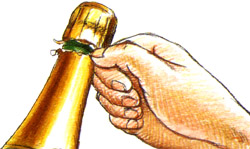
Remove the wire fastener or any foil covering the cork. If the bottle is properly cooled, the cork should not pop off.
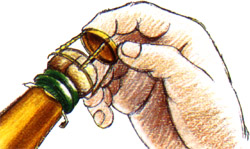
Find one of the two seams running down the side of the bottle. The seam should be fully uncovered, with no foil covering it. However, it is possible to perform the sabrage with the foil on, if you are experienced enough.
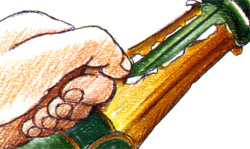
Hold the bottle firmly at the bottom, with your thumb in the “punt” (the indentation in the base of the bottle). Then stretch your arms out so that the bottle neck is as far away from your body as possible. You should hold the bottle at a 30-degree angle. Make sure that nobody is standing within potential range.
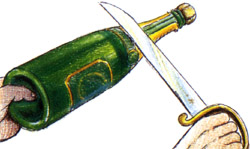
Hold the blade of the sabre flat against the bottle with the blunt edge facing the lip. Run the blade along the seam,
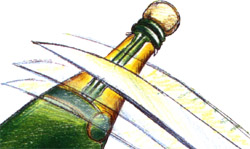
and then firmly and quickly push the blade forward. The blade will hit the spot where the seam meets the lip of the bottle, and the neck should pop off. The cork will sit firmly in the severed part. Sabrage severs the neck with the cork from the rest of the bottle. There will be clean cut. If you have performed sabrage correctly, any glass shards will be pushed out of the bottle after impact. Then you can serve your guests.
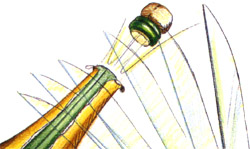
The sabrage technique may look easy at first glance. But the opposite is true. Look at this video to get an idea of what it looks like when things don’t go as planned.

We Can Help with the Swords
Some people are able to perform clean sabrage with an ordinary kitchen knife or even a machete. We recommend to leave these experiments to professionals. Only use champagne swords that are made of top-quality stainless steel and other properties optimized for this technique.
We also have a gift set for sabrage that will impress even most demanding champagne connoisseurs. Gift sets are perfect as decorations placed next to private champagne collections. It comes with a wooden gift box which also serves as a sabre stand. An Italian Maserin sabre does the trick equally well, and comes with an elegant wooden box too.

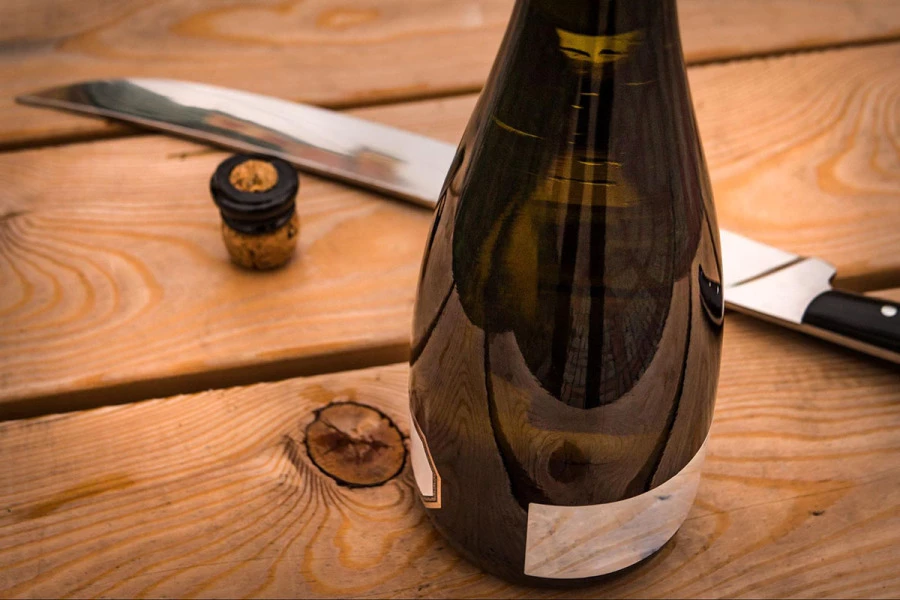


Comments